Oh. Okay.
I was intrigued. Like hundreds of other people who've looked at a Seven, I thought, "Hey, I could build one of those." Colin Chapman reportedly did his first car in his living room; hell, I have a pretty nice workshop and a lot more tools than Chapman did then.
One problem was, I already *had* a project - the Kelmark/Marauder, which was fairly far along in the parts-collecting stage. However, there was a sizeable amount of FUD (fear, uncertainty, doubt) about welding up a chassis from scratch. Not to mention all the details of a fairly complex mid engine, 4wd layout. A Seven, on the other hand...
I'm subject to sudden enthusiasms. Most of them don't go anywhere, but it beats watching TV. Anyway, I talked about it to fellow car geek Ron Melson, who I've known since high school. Ron dug up a bunch more stuff on Sevens, including some decent chassis and suspension drawings. I kept thinking about it. I have a 1971 Capri with an almost-new 2.0, but the body is succumbing to terminal rot. I'd already planned to retire the car at the end of the year, and I didn't have anything else to do with the driveline... if I scavenged the as much stuff as possible from the Capri, I might be able to build a Seven for say, somewhere between $500 and $1000.
I didn't want to jump tracks with so much invested in the Marauder, but a Seven would be simple enough for me to get some practice and confidence, and I could always sell the Seven clone after I was done. I talked about it with AB, my wife, who objected strongly. No, there would be no selling it. *She* would drive it. When would it be finished?
Oh. Okay.
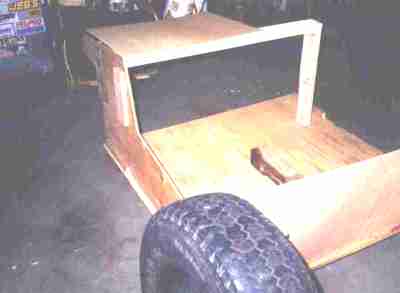 Ron and I built the wooden cockpit mockup in June. I'm bulky and I've had knee
surgery; I wanted to be sure I could get in and out of a 7 before I spent much
more time making plans. Ron came over and we used some scrap wood I had in
the shop to make the mockup. A Series I 7 was 39.5 inches wide. Current
Caterhams are 42 inches. The mockup showed that was awfully tight; we decided
to use 46 inches. That was fortunate, as it worked well with the widths of
the rear end front end bits we wound up with.
Ron and I built the wooden cockpit mockup in June. I'm bulky and I've had knee
surgery; I wanted to be sure I could get in and out of a 7 before I spent much
more time making plans. Ron came over and we used some scrap wood I had in
the shop to make the mockup. A Series I 7 was 39.5 inches wide. Current
Caterhams are 42 inches. The mockup showed that was awfully tight; we decided
to use 46 inches. That was fortunate, as it worked well with the widths of
the rear end front end bits we wound up with.
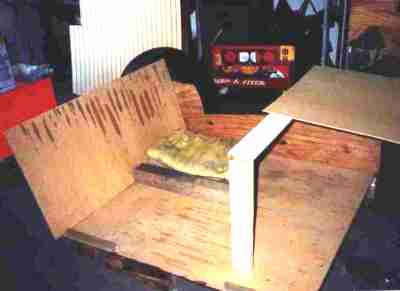 Yes, it's at ride height - actually, it's almost an inch higher than a Series
I 7! You can touch the ground with your fingertips. The side cutout has a
higher sill than a Series I, but your lap is still higher than the edge.
If something fell out of your pocket the tire would run over it.
Yes, it's at ride height - actually, it's almost an inch higher than a Series
I 7! You can touch the ground with your fingertips. The side cutout has a
higher sill than a Series I, but your lap is still higher than the edge.
If something fell out of your pocket the tire would run over it.
Even sitting in the mockup it was apparent why people were so impressed after
a ride in a 7. The open sides make you feel very exposed, in a way you don't
get when you're on a motorcycle. Very odd. The hood also seems much taller
from the driver's seat than from outside.
I was in no particular hurry; I had plenty of irons in the fire already and funds were short. Ron was saying he'd like to have a similar car. We did some measuring on a Chevy straight six he had, which would have fit fine. However, due to circumstances not really relevant here, he decided to scrap his project Mustang and use it as a donor for his car. And he was willing to buy the materials and start right now.
Oh. Okay.
We weren't planning to build an accurate Seven replica, just to use the basic idea and build our own car. Sort of a 'stand-off scale' Seven. We knew the 5.0 would be overkill for such a small car, but "Free is a quality overcoming many faults."
Our initial plan:
1984 Ford 5.0 V8, T5 5-speed
Mustang steering knuckles, power rack, instruments, steering
column, pedal assembly, brake booster and master cylinder,
parking brake, and wiper mechanism
15x7 wheels, 235-70/15 tires from the Mustang
1985 Nissan Maxima semi-trailing-arm IRS, disc brakes, 3.36:1 ratio
estimated weight: 1500 pounds
That left a lot of details unstated, deliberately. We've been making
decisions as we go. Lots of the parts we scavenged from the Mustang were
bigger and/or heavier than we needed, and other stuff was sometimes not
optimal, but we're going for expedience instead of perfection. We've both had
enough terminally stalled projects; we intend to get this one on the road
quickly.
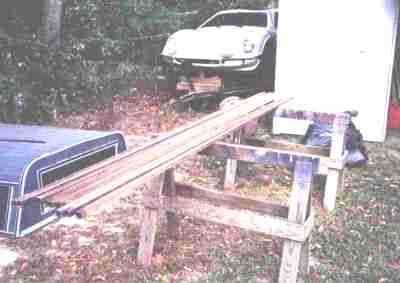 Ron's first investment - $60 worth of 1" square steel tubing from a salvage
and remainder yard. That's my Kelmark body sitting on a trailer in the
background.
Ron's first investment - $60 worth of 1" square steel tubing from a salvage
and remainder yard. That's my Kelmark body sitting on a trailer in the
background.
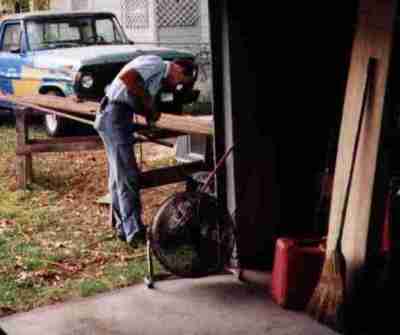 If we had only known... the tubing we got was rusty and had to be cleaned
before we used it. And it turned out to be hot rolled. It's the same
strength as cold rolled, but nasty to weld. We found out later we could have
got new cold rolled tubing for less money. [sigh]
If we had only known... the tubing we got was rusty and had to be cleaned
before we used it. And it turned out to be hot rolled. It's the same
strength as cold rolled, but nasty to weld. We found out later we could have
got new cold rolled tubing for less money. [sigh]
Ron spent close to 8 hours with the disc sander and wire wheel cleaning the
stuff up.
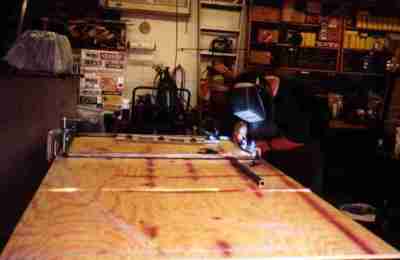 We had already decided to build 7s when Ron's wife got him a book called "How
To Make Your Own Sports Car for #250". [British pounds] The book, by Ron
Champion, described the construction of a car similar to a Lotus 7, called a
'Locost'. We had already deviated substantially from the Lotus/Locost layout,
but the book was a great source of tips and techniques, one of which was to
use a sheet of plywood to build the chassis on. Ron snagged a sheet of 1/2"
ply and we used the tape measure and chalk line to mark the outlines where the
lower tubes went. We slid most of our stock of 1" tubing between the
sawhorses and plywood, leveled everything up, and used a lot of C-clamps.
We had already decided to build 7s when Ron's wife got him a book called "How
To Make Your Own Sports Car for #250". [British pounds] The book, by Ron
Champion, described the construction of a car similar to a Lotus 7, called a
'Locost'. We had already deviated substantially from the Lotus/Locost layout,
but the book was a great source of tips and techniques, one of which was to
use a sheet of plywood to build the chassis on. Ron snagged a sheet of 1/2"
ply and we used the tape measure and chalk line to mark the outlines where the
lower tubes went. We slid most of our stock of 1" tubing between the
sawhorses and plywood, leveled everything up, and used a lot of C-clamps.
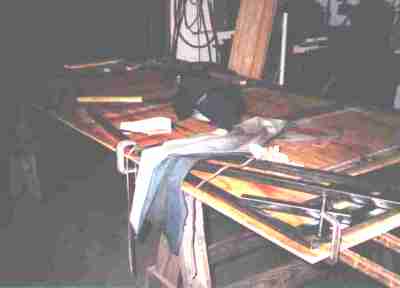 It's not a heavy machined steel surface plate like the fancy race car and
street rod shops use, but it's close enough. We were within 1/32" from end to
end, which is a hell of a lot closer than Detroit gets! One of the major
realizations from the project was that we didn't need perfection; sometimes
"close enough" really *is* close enough.
It's not a heavy machined steel surface plate like the fancy race car and
street rod shops use, but it's close enough. We were within 1/32" from end to
end, which is a hell of a lot closer than Detroit gets! One of the major
realizations from the project was that we didn't need perfection; sometimes
"close enough" really *is* close enough.
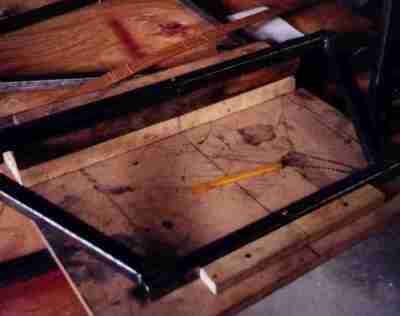 We used the Locost design for the front bulkhead. I made this fixture to hold
the pieces. You can barely see the 1/8" holes drilled in the horizontal
tubes. They are in the center of each tube and define the centerline of the
chassis. The rear tubes have similar holes. This will let us check our
alignment as we work on the chassis and provide a true centerline for welding
the suspension pieces on and aligning the wheels.
We used the Locost design for the front bulkhead. I made this fixture to hold
the pieces. You can barely see the 1/8" holes drilled in the horizontal
tubes. They are in the center of each tube and define the centerline of the
chassis. The rear tubes have similar holes. This will let us check our
alignment as we work on the chassis and provide a true centerline for welding
the suspension pieces on and aligning the wheels.
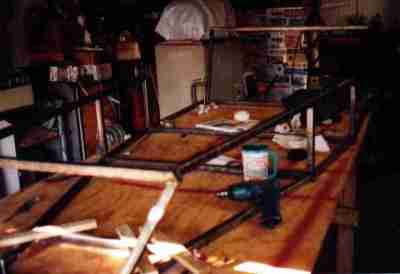 The main tubes are all in place and I've unclamped the chassis so I can roll
it around and weld underneath. It's quite flexible at this point as there is
no triangulation.
The main tubes are all in place and I've unclamped the chassis so I can roll
it around and weld underneath. It's quite flexible at this point as there is
no triangulation.
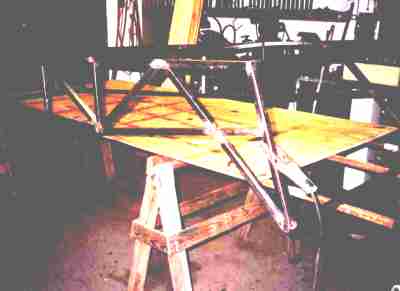 Triangulation pieces are welded on here. The chassis had to be carefully
leveled and trued, and I checked the alignment after every piece was welded
in. The diagonals made it much stiffer.
Triangulation pieces are welded on here. The chassis had to be carefully
leveled and trued, and I checked the alignment after every piece was welded
in. The diagonals made it much stiffer.
One of the deviations from the Lotus design is the "kink point" at your hip,
just ahead of the rear wheel. I think my layout is much stronger. Colin
Chapman only had to deal with 50 hp on the first 7s; Ron's 225 hp 5.0 would
turn a real 7 into a pretzel. You'll see later where I've added extra tubes
for stiffening.
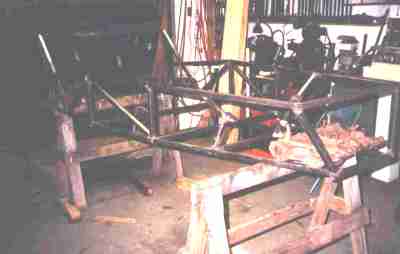 Here it is flipped back rightside up. Old cast iron intake manifold helps
weight it down onto the leveling shims. It will remain straight after the
diagonals are welded in. Welding puts all sorts of residual stresses into the
structure; it tries to turn into op art as you progress, so you have to keep
straightening it as you go. Once it's done it'll stay straight.
Here it is flipped back rightside up. Old cast iron intake manifold helps
weight it down onto the leveling shims. It will remain straight after the
diagonals are welded in. Welding puts all sorts of residual stresses into the
structure; it tries to turn into op art as you progress, so you have to keep
straightening it as you go. Once it's done it'll stay straight.
Meanwhile, concurrently with this, we strip Ron's project Mustang of its naughty bits. The only day we had to do it was a nice sunny 109 F Arkansas brain-frying summer day. We probably drank five gallons of water. Each. Not to mention getting sunburned. And grouchy. But we made it...
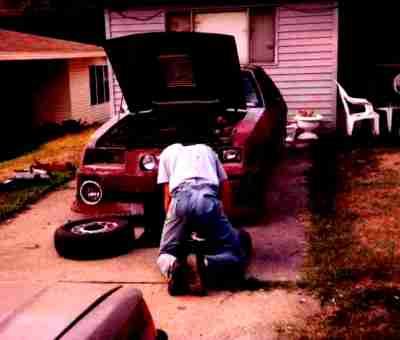 Ron's jacking the car up so we can get started.
Ron's jacking the car up so we can get started.
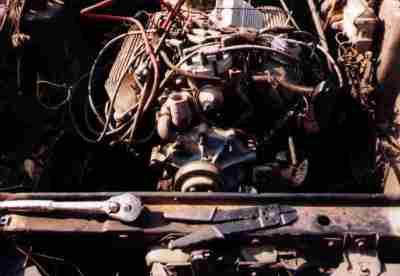 The carbureted 5.0 in its native habitat. It's an '84 model. The engine is
old and a bit weak in the knees, but it has a new clutch and a good five
speed. Ron's 281 destroker will replace the 5.0 after the car gets on the
road.
The carbureted 5.0 in its native habitat. It's an '84 model. The engine is
old and a bit weak in the knees, but it has a new clutch and a good five
speed. Ron's 281 destroker will replace the 5.0 after the car gets on the
road.
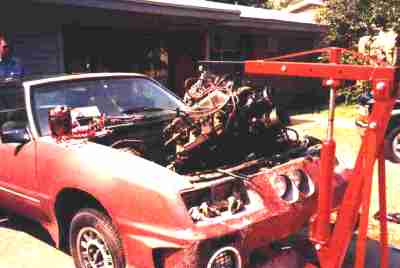 The magic moment... well, for some reason we had a hell of a time getting the
thing tilted just right to clear the shifter, but it was a great victory all
the same. Anything is a great victory when the sun is frying your brains.
The magic moment... well, for some reason we had a hell of a time getting the
thing tilted just right to clear the shifter, but it was a great victory all
the same. Anything is a great victory when the sun is frying your brains.
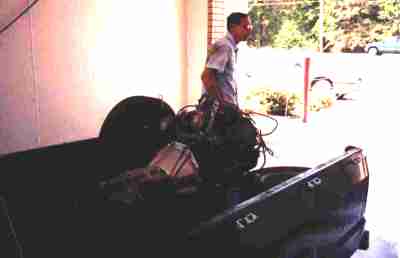 We blew $5 at the local car wash while we were taking the engine and trans
over to my place. It's in the early afternoon and neither one of us is moving
fast any more.
We blew $5 at the local car wash while we were taking the engine and trans
over to my place. It's in the early afternoon and neither one of us is moving
fast any more.
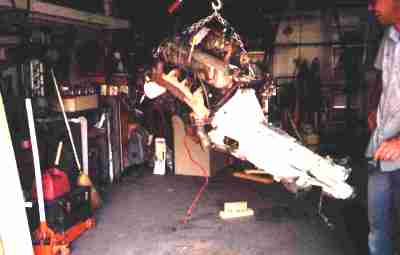 The 5.0 has arrived! You can see the chassis standing up against the back
wall of the shop.
The 5.0 has arrived! You can see the chassis standing up against the back
wall of the shop.
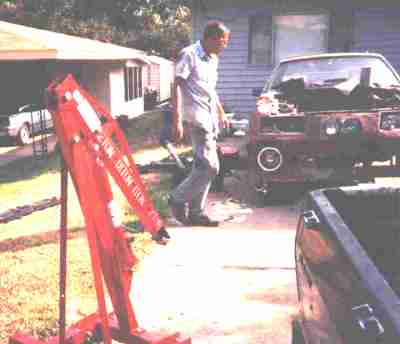 But wait! There's more! We planned to scavenge some of the front end parts,
so we dropped the K-member, which turned out to be a real pain in the ass.
We'd already disassembled the engine hoist and put it in Ron's shed, then we
found out we were too tired to even drag the loaded K-member, much less lift
it into the truck! So we reassembled the hoist...
But wait! There's more! We planned to scavenge some of the front end parts,
so we dropped the K-member, which turned out to be a real pain in the ass.
We'd already disassembled the engine hoist and put it in Ron's shed, then we
found out we were too tired to even drag the loaded K-member, much less lift
it into the truck! So we reassembled the hoist...
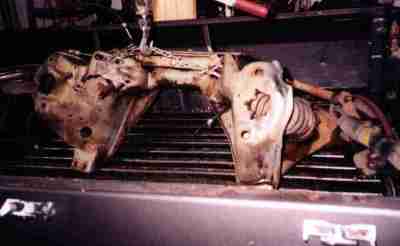 The K-member in the back of my Mazda pickup. Do you care? Probably not. But
to us... it was a major event. By this time we're sunburned, dehydrated,
exhausted, and generally wasted. It's been a long, long day. I took a
photograph to celebrate.
The K-member in the back of my Mazda pickup. Do you care? Probably not. But
to us... it was a major event. By this time we're sunburned, dehydrated,
exhausted, and generally wasted. It's been a long, long day. I took a
photograph to celebrate.
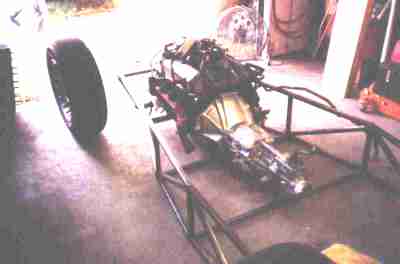 Back at my place with the K-member. We were too tired to unload it, so we
blocked the engine and chassis in place to see how things fit. Not bad eh?
The 7s put the engine way forward; we pulled the 5.0 back as far as we could.
Back at my place with the K-member. We were too tired to unload it, so we
blocked the engine and chassis in place to see how things fit. Not bad eh?
The 7s put the engine way forward; we pulled the 5.0 back as far as we could.
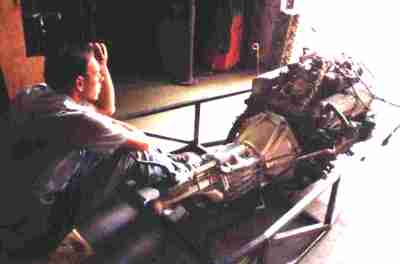 Don't be fooled by Ron's thoughtful expression; I think he was passed out when
I took this shot. At this time we're only two weeks from "go". Not bad eh?
Don't be fooled by Ron's thoughtful expression; I think he was passed out when
I took this shot. At this time we're only two weeks from "go". Not bad eh?
...and that's the end of that long, long day!
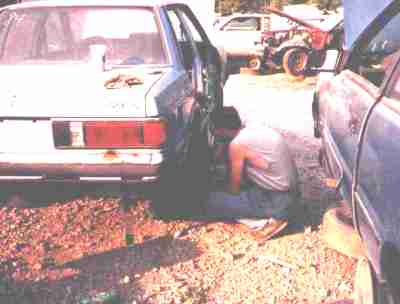 Next week we're at the local (only 35 miles away) U-Pull-It junkyard armed
with measuring tape and tools. It turned out almost all the potential IRS
donor cars were right at 57 inches flange-to-flange. We picked a Nissan
Maxima as the donor. It's 10 AM, barely 100 degrees yet.
Next week we're at the local (only 35 miles away) U-Pull-It junkyard armed
with measuring tape and tools. It turned out almost all the potential IRS
donor cars were right at 57 inches flange-to-flange. We picked a Nissan
Maxima as the donor. It's 10 AM, barely 100 degrees yet.
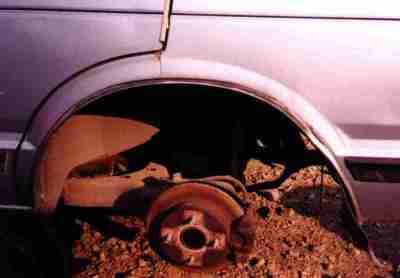 The Maxima had semi-trailing arms and rear discs. The rear is essentially the
same as the one under a 280ZX, except they had a lot of Maximas at the
junkyard and no complete ZX rears.
The Maxima had semi-trailing arms and rear discs. The rear is essentially the
same as the one under a 280ZX, except they had a lot of Maximas at the
junkyard and no complete ZX rears.
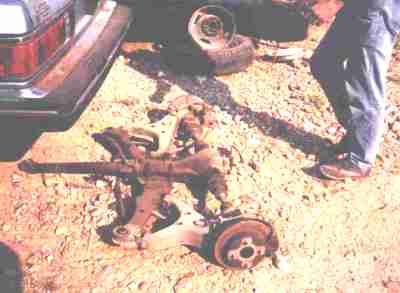 Thirty minutes later. Four bolts, parking brake cable, brake hose, and twenty
minutes of fighting the exhaust pipe out of the way. The whole wazoo drops
out as an assembly. It cost Ron $100, and another $20 for the driveshaft.
Thirty minutes later. Four bolts, parking brake cable, brake hose, and twenty
minutes of fighting the exhaust pipe out of the way. The whole wazoo drops
out as an assembly. It cost Ron $100, and another $20 for the driveshaft.
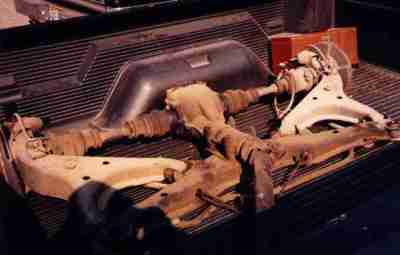 In Ron's truck for the ride home. We'll be disposing of the crossmember and
most of the arms later; the junkyard didn't care if we took the whole thing.
In Ron's truck for the ride home. We'll be disposing of the crossmember and
most of the arms later; the junkyard didn't care if we took the whole thing.
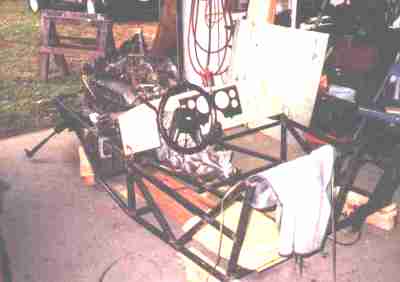 This is almost a month later. There's a lot of work here, but you can't see
much from the picture. The motor mounts are done and the engine is bolted
down; the cowl frame is built, and we've decided where to put the dashboard
and steering column. Since cost is a big factor here, we've decided to use
the Mustang's instrument cluster, which had to be scooted over to the middle
to clear the column.
This is almost a month later. There's a lot of work here, but you can't see
much from the picture. The motor mounts are done and the engine is bolted
down; the cowl frame is built, and we've decided where to put the dashboard
and steering column. Since cost is a big factor here, we've decided to use
the Mustang's instrument cluster, which had to be scooted over to the middle
to clear the column.